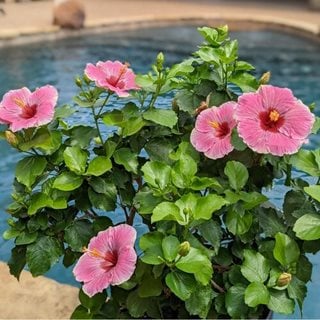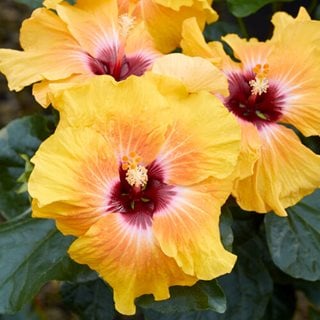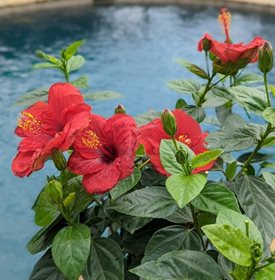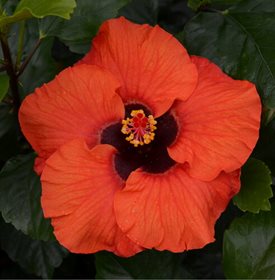HOW TO GROW AND CARE FOR TROPICAL HIBISCUS
Add vibrant color and drama to the landscape with these flamboyant flowering tropical plantsFew ornamental garden plants rival the drama and excitement that tropical hibiscus brings to the landscape. Showy trumpet-shaped flowers, which are attractive to butterflies and hummingbirds, can reach up to 10 inches wide. Blooms occur in warm shades of red, orange, peach, coral, and yellow, as well as pure white. When given the right growing conditions, tropical hibiscus plants will flower continuously from late spring into fall, and nearly year-round in frost-free climates.
Individual flowers last just a day, but some newer hybrids produce flowers that can last up to 3 days. A member of the mallow family (Malvaceae), tropical hibiscus is native to subtropical and tropical regions of Asia, and is the national flower of Malaysia. Learn how to grow and use this exotic flowering plant in your yard.
On this page: Basics | Planting | Care | Varieties | Common Problems | FAQs | Design Ideas
On this page:
- BASICS
- HOW TO PLANT TROPICAL HIBISCUS
- TROPICAL HIBISCUS CARE
- TROPICAL HIBISCUS VARIETIES
- COMMON PROBLEMS WITH TROPICAL HIBISCUS
- FREQUENTLY ASKED QUESTIONS
- LANDSCAPE DESIGN IDEAS
BASICS
Botanical name:
Hibiscus rosa-sinensis
Common names:
Tropical hibiscus, Chinese hibiscus, China rose, Hawaiian hibiscus, shoeblack plant
Plant type:
Perennial evergreen shrub or small tree, grown as an annual in colder zones
Zones:
9-12
Exposure:
Full sun to partial shade
Habit:
Upright bushy habit
Height/Spread:
4 to 10 feet tall, 3 to 8 feet wide, smaller when grown as an annual
Bloom Time:
Late spring to fall; nearly year-round in frost-free climates
Flowers:
Single or double, trumpet-shaped flowers, 2 to 10 inches wide, have showy protruding stigmas and anthers. Blooms occur in solid or multi-colors, primarily in shades of red, pink, yellow, orange, purple, or white. Some varieties produce a range of colors in a single bloom. Flowers are edible and commonly eaten in salads in native cultures.
Foliage:
Evergreen serrated leaves are round or oval and pointed at the tip. Foliage is green or variegated with a glossy sheen.
HOW TO PLANT TROPICAL HIBISCUS
When to plant:
Wait until minimum temperatures are regularly 50 degrees F or higher to place plants in the ground or containers. Colder temperatures may damage or kill plants.
Where to plant:
Choose a wind-sheltered site with rich, well-draining soil that gets at least 6 hours of direct sunlight. Provide afternoon shade in hotter climates. Too much shade will result in leggy growth and fewer flowers.
How to plant:
Loosen soil in the planting area and amend with compost or other rich organic matter. Dig a hole twice as wide and the same depth as the root ball. Remove plant from the nursery container and tease out roots if potbound. Place in the hole so the top of the root ball is level with the surrounding soil. Fill in the hole with soil, tamp down gently to remove air pockets, and water thoroughly. Mulch around the base with compost or other organic matter to suppress weeds and retain moisture, being sure to keep mulch away from the trunk and stems. Space plants 3 feet apart.
TROPICAL HIBISCUS CARE
Temperature and humidity:
Tropical hibiscus is native to warm climates, with optimal temperatures between 55 to 85 degrees F. Avoid temperatures below 50 degrees F, which can damage or kill plants. Temperatures above 90 degrees F may cause bud drop. Tropical hibiscus prefers high humidity as found in its native habitat.
Soil:
Tropical hibiscus plants perform best in rich, well-drained soil with a neutral to slightly acidic pH between 6.0 and 7.0. For containers, use a high-quality, all-purpose potting mix. Perlite may be added to improve drainage.
Water:
Tropical hibiscus prefers regular moisture. Provide 1 to 2 inches of water per week. Don’t allow soil to dry out completely. Containers need more frequent watering than plants in the ground. Avoid overwatering to prevent root rot, and make sure containers have adequate drainage holes. Overhead watering or poor air circulation may lead to fungal diseases.
Learn the one tricky thing about growing Hollywood Hibiscus™, from Stacey at Proven Winners ColorChoice® Shrubs.
Amendments and fertilizer:
At the time of planting, mix an all-purpose, slow-release fertilizer into the soil according to instructions. Supplement with an organic liquid fertilizer according to instructions during spring and summer when plants are actively growing. Cease fertilizing in fall when plant growth slows down.
Tip: Use a balanced fertilizer (i.e., 10-10-10), not one high in phosphorus (the middle number) such as a "bloom booster," as this can cause yellowing foliage and a decrease in flowering.
Pruning:
Tropical hibiscus flowers on the current season’s growth. Pruning improves plant shape and air circulation, stimulates vigorous growth, and promotes branching, resulting in more flowers. In frost-free regions, tropical hibiscus can be pruned in fall. Remove discolored leaves and dead, diseased, or broken branches and lightly shape plants as needed. For colder regions, prune in early spring when new growth begins to emerge.
Deadheading:
Deadhead spent hibiscus flowers to promote new buds.
Growing in containers:
Repot hibiscus plants every 1 to 2 years. Remove plant from its container, gently shake to remove old soil, and repot in fresh soil. If plants are root bound, tease out roots and repot in a container that is 2 inches larger in diameter.
Overwintering potted plants indoors:
Bring plants inside at the end of the growing season when minimum outside temperatures reach 50 degrees F. Colder temperatures can result in plant damage. Plants can be cut back by up to half their size before bringing indoors.
Place hibiscus plants in a room with bright light that receives at least 2 to 3 hours of direct sunlight per day. Reduce watering to no more than once or twice a week. Mist foliage regularly to boost humidity as needed. Remove flower buds to divert energy back into the plant. Move plants outdoors in spring when temperatures are consistently above 50 degrees F.
Pests and diseases:
When given optimal growing conditions, tropical hibiscus is free of most pests and diseases. Pests can include aphids, mealy bugs, scale, spider mites, thrips and whiteflies. Diseases include black spot, botrytis, leaf wilt, powdery mildew, root rot and stem rot.
Deer resistance:
Tropical hibiscus is generally deer resistant, though deer will graze on almost any plant if they are hungry enough.
TROPICAL HIBISCUS VARIETIES
COMMON PROBLEMS WITH TROPICAL HIBISCUS
The most common problems with tropical hibiscus include:
Leaf drop:
Hibiscus plants can experience a loss of leaves from underwatering, excessive heat or being root bound.
Yellow leaves:
Possible causes of yellow leaves include overwatering, underwatering, or lack of fertilizer. Older leaves naturally turn yellow and drop off the plant, which is part of the normal life cycle.
Flower bud drop:
Sudden changes in light or temperatures may cause flower buds to drop off. To minimize bud drops, provide consistent growing conditions and avoid prolonged temperatures above 95 degrees F.
FREQUENTLY ASKED QUESTIONS
Do tropical hibiscus come back every year?
Tropical hibiscus is a perennial plant in frost-free climates. In colder regions, it can be grown as an annual or overwintered indoors.
What is the difference between tropical hibiscus and hardy hibiscus?
Tropical hibiscus will only survive outdoors year-round in frost-free zones. Hardy hibiscus, including common rose mallow (Hibiscus moscheutos) and rose of Sharon (H. syriacus) can overwinter outdoors in most growing regions. Tropical hibiscus is an evergreen shrub or small tree, while hardy types are deciduous shrubs or herbaceous perennials.
Do tropical hibiscus need full sun?
Tropical hibiscus produces the most flowers when it receives at least 6 hours of direct sunlight, though will benefit from afternoon shade in hotter climates.
Can I leave my tropical hibiscus outside in winter?
In frost-free climates, tropical hibiscus can stay outside for the winter. In colder regions, bring plants indoors or treat as an annual.
How do I know if my hibiscus is perennial or tropical?
When buying hibiscus plants, look on the label to see what species you are buying, and for hardiness zone information.
How fast does Hibiscus rosa-sinensis grow?
Tropical hibiscus has a medium growth rate, producing up to 2 feet of new growth in a single growing season.
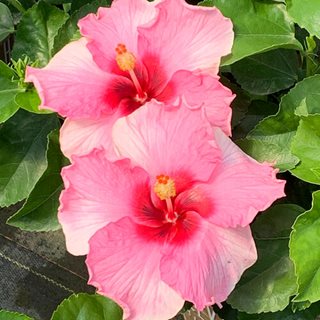
Hollywood Hibiscus™ Talk of the Town™. Photo: Proven Winners
TROPICAL HIBISCUS LANDSCAPING TIPS
For borders and landscapes:
Plant tropical hibiscus in beds, shrub borders, and foundation plantings. Use as a showy focal point, hedging or screening, or massed in the landscape.
For slopes and hillsides:
Use tropical hibiscus with other plants or mass by itself along a slope as a fast-growing solution to help stem erosion.
For containers:
Tropical hibiscus can be planted in a container by itself or in combination with other plants with similar growing needs.
There are many ways to use tropical hibiscus in your landscape. Here’s how:
- In frost-free climates, plant tropical hibiscus in a row along a fence or property line as hedging or screening.
- Include tropical hibiscus in a foundation planting along with other shrubs in different sizes and shapes for season-long color.
- Use tropical hibiscus as a “thriller” element in a large container in combination with compact and trailing plants for a “thriller, filler, spiller” effect.
- Mass tropical hibiscus in a bed for weeks of continuous color.
- Plant a tropical hibiscus in a decorative container by itself and showcase as a focal point on a deck, patio or in the landscape.
- Mass tropical hibiscus along a slope or hillside to help stem erosion.
- Add tropical hibiscus to a bed or mixed border in combination with other tropical-looking plants such as canna lily, elephant ears, hardy banana, and coleus for a flamboyant display.
- Decorate a poolside or spa with tropical hibiscus and other bold plants such as bird of paradise, palms, and alocasia to evoke the feeling of a lush resort.
- Plant tropical hibiscus in beds or decorative containers at your home’s entrance for a dramatic first impression.
Companion plants: Combine tropical hibiscus with other plants with similar growing needs. These include bird of paradise, brugmansia, canna lily, coleus, elephant ears, fuchsia, gardenia, hardy banana, ginger lily, jasmine, lantana, mandevilla, marigold, palms, passion flower, petunia, plumeria, and sweet potato vine.
RELATED:
How to Grow Rose of Sharon
Flowering Shrubs
Tropical Gardens

